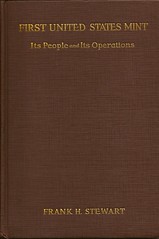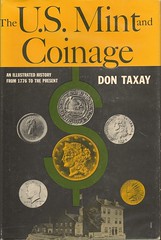
PREV ARTICLE
NEXT ARTICLE
FULL ISSUE
PREV FULL ISSUE
KARL MOULTON ON JOHN ECKSTEIN, ENGRAVER
Jim Wells' earlier query on the model for U.S. Draped Bust coinage has led to some interesting discussion, which continues this week as Karl Moulton follows up on R. W. Julian's comments last week.
-Editor
A few statements about Eckstein were made last week by R.W. Julian. Mr. Julian wrote, "Eckstein did not engrave any dies for United States coinage". He also wrote, "The "models" made by Eckstein in September of 1795 were actually plaster models for the use of Robert Scot, who did engrave the hubs and dies for this coinage...". Did the Mint Director, in September of 1795, really pay $30 dollars for two small plaster casts? Thirty dollars was at least a month's wages for that timeframe. This would have been unthinkable, especially after the February 1795 Congressional investigation into the cost of operating the Mint. However, if this be fact, as stated, then let's see Mr. Julian's validation and supporting evidence for his statement. Let's see what other researchers have written about Eckstein.
Previously, in November of 1794, John Smith Gardner was hired as an assistant engraver because Scot was not skilled enough to do the entire job that the position of engraver demanded. Gardner was never commissioned as such, but he was an "assistant" and did engrave dies. Eckstein was a talented and skilled artist. Before he came to America, he had listed himself as a "historical painter and statuary to the King of Prussia". In Taxay, p.106, we see, "According to Sully, Eckstein was "a thorough-going drudge in the arts. He could do you a picture in still life - history - landscape - portrait - he could model - cut a head in marble - or anything you please". Because he was most likely copying from Stuart's large painting of Anne Bingham, he was able to scale it down to fit a small model for the unfinished dies. Proof of his ability to do this can be found in George Escol Seller's 19th century writings, which were later combined and put out in a 1965 book published by the Smithsonian Institution, where he wrote of Eckstein, p.38, "Mr. Evans (Oliver, who constructed and installed the first steam engine in the first United States Mint in 1816) made all his drawings full size on chalked boards; he had no confidence in working to scale with the character of labor to be had at that time...To combine and reduce these full size working drawings and put them into shape for exhibit, he depended upon Frederick and John Eckstein, then copperplate engravers in Philadelphia". To quote Taxay further, p.106, "De Suassure apparently did not even trust Scot to prepare a die from Stuart's drawing...It was probably Eckstein, rather than Stuart, who redesigned the eagle". In the 18th and 19th centuries, engravers did not have to work at, or be at, the Mint. This is evidenced by Scot having John Reich work on dies "for the national coin" several years before he was appointed as the assistant engraver in April of 1807. This is brought out in the 1884 three volume set titled, "The History of Philadelphia" by Scharfe and Westcott. In 1818, when he was living in Philadelphia, Jacob Perkins created a few patterns for the proposed dollars, which were not accepted. In 1824, Luigi Persico was paid $80, "for modeling a small medallion head for the silver coins" (Stewart, p.188). Based on what others have reported, along with my own research into the activities of the early Mint, I submit that John Eckstein - a skilled engraver and artist (and not Robert Scot) was the engraver for the two dies of the Anne Bingham portrait that is seen on the Draped Bust silver dollars, beginning in 1795.
To read the complete articles, see:
The Numismatic Bibliomania Society is a non-profit organization promoting numismatic literature. See our web site at coinbooks.org. To submit items for publication in The E-Sylum, write to the Editor at this address: whomren@gmail.com To subscribe go to: https://my.binhost.com/lists/listinfo/esylum All Rights Reserved. NBS Home Page Contact the NBS webmaster 
|

